Commercial Law Case Study: Analyzing Negligence, Duty & Remedies
VerifiedAdded on 2023/06/15
|9
|1821
|125
Case Study
AI Summary
This case study delves into two distinct scenarios under commercial law. The first scenario involves a pedestrian accident where Katie, while driving, hits Max due to texting and inattention, and Rita, a witness, suffers a nervous breakdown. The analysis focuses on determining negligence, duty of care, and potential remedies available to Max and Rita under the Civil Liability Act 2002 (NSW). The second scenario examines Robbie's fraudulent loan application to XYZ bank, misrepresenting his land's value with Harry from ABC Appraisals assisting. The analysis covers misrepresentation, misleading conduct under the Australian Consumer Law (Competition and Consumer Act 2010), and the bank's negligence in verifying the valuation, assessing potential claims and liabilities. The document concludes by referencing relevant Australian case law.
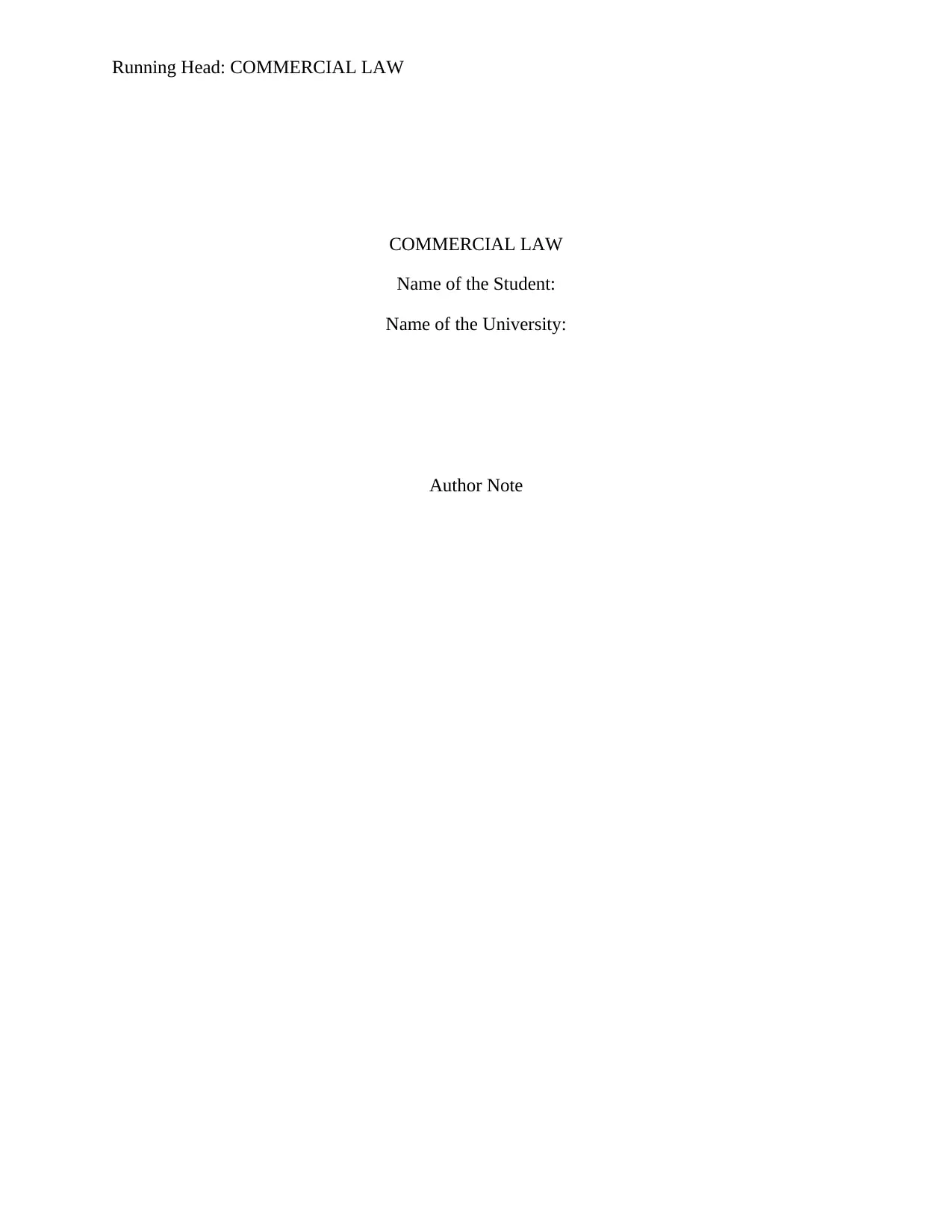
Running Head: COMMERCIAL LAW
COMMERCIAL LAW
Name of the Student:
Name of the University:
Author Note
COMMERCIAL LAW
Name of the Student:
Name of the University:
Author Note
Paraphrase This Document
Need a fresh take? Get an instant paraphrase of this document with our AI Paraphraser
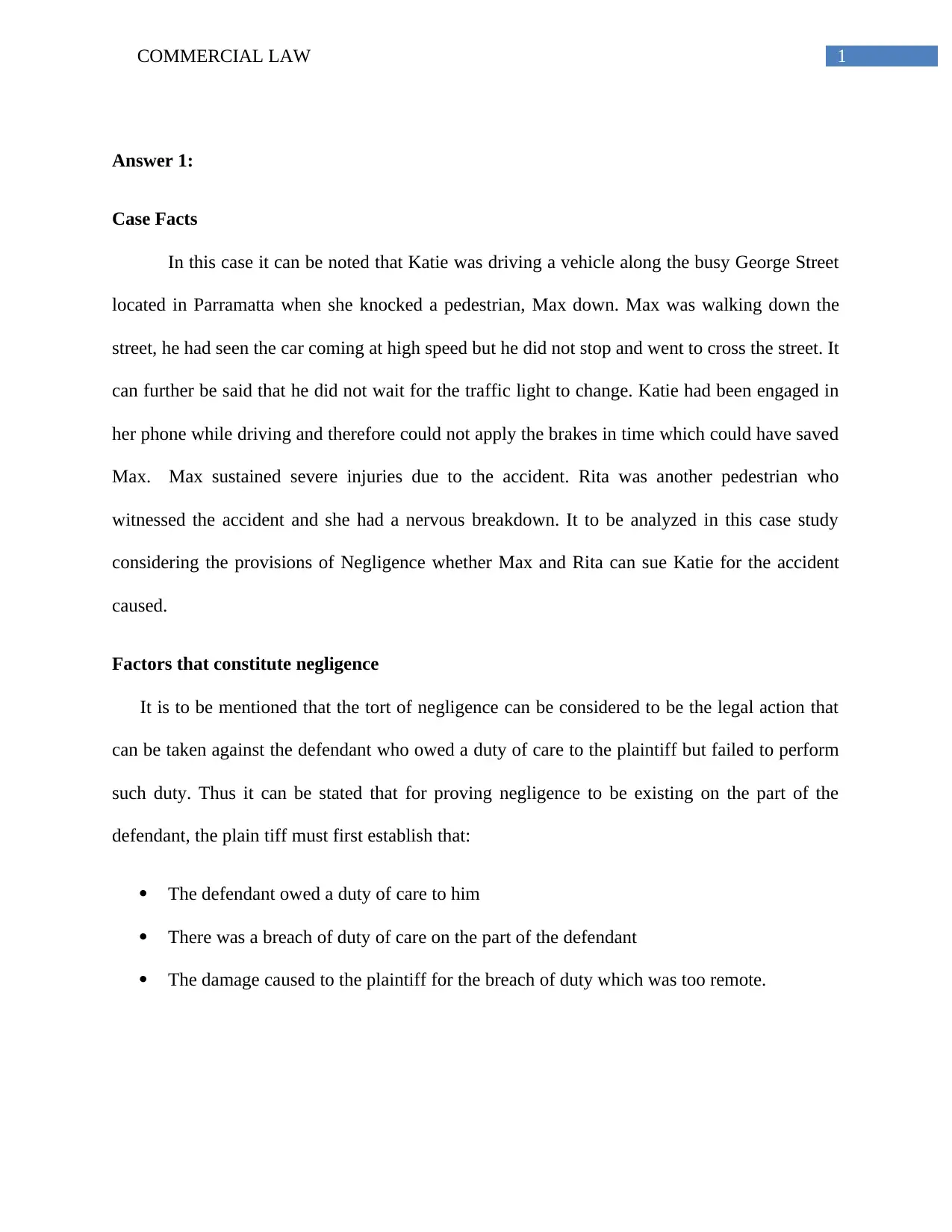
1COMMERCIAL LAW
Answer 1:
Case Facts
In this case it can be noted that Katie was driving a vehicle along the busy George Street
located in Parramatta when she knocked a pedestrian, Max down. Max was walking down the
street, he had seen the car coming at high speed but he did not stop and went to cross the street. It
can further be said that he did not wait for the traffic light to change. Katie had been engaged in
her phone while driving and therefore could not apply the brakes in time which could have saved
Max. Max sustained severe injuries due to the accident. Rita was another pedestrian who
witnessed the accident and she had a nervous breakdown. It to be analyzed in this case study
considering the provisions of Negligence whether Max and Rita can sue Katie for the accident
caused.
Factors that constitute negligence
It is to be mentioned that the tort of negligence can be considered to be the legal action that
can be taken against the defendant who owed a duty of care to the plaintiff but failed to perform
such duty. Thus it can be stated that for proving negligence to be existing on the part of the
defendant, the plain tiff must first establish that:
The defendant owed a duty of care to him
There was a breach of duty of care on the part of the defendant
The damage caused to the plaintiff for the breach of duty which was too remote.
Answer 1:
Case Facts
In this case it can be noted that Katie was driving a vehicle along the busy George Street
located in Parramatta when she knocked a pedestrian, Max down. Max was walking down the
street, he had seen the car coming at high speed but he did not stop and went to cross the street. It
can further be said that he did not wait for the traffic light to change. Katie had been engaged in
her phone while driving and therefore could not apply the brakes in time which could have saved
Max. Max sustained severe injuries due to the accident. Rita was another pedestrian who
witnessed the accident and she had a nervous breakdown. It to be analyzed in this case study
considering the provisions of Negligence whether Max and Rita can sue Katie for the accident
caused.
Factors that constitute negligence
It is to be mentioned that the tort of negligence can be considered to be the legal action that
can be taken against the defendant who owed a duty of care to the plaintiff but failed to perform
such duty. Thus it can be stated that for proving negligence to be existing on the part of the
defendant, the plain tiff must first establish that:
The defendant owed a duty of care to him
There was a breach of duty of care on the part of the defendant
The damage caused to the plaintiff for the breach of duty which was too remote.
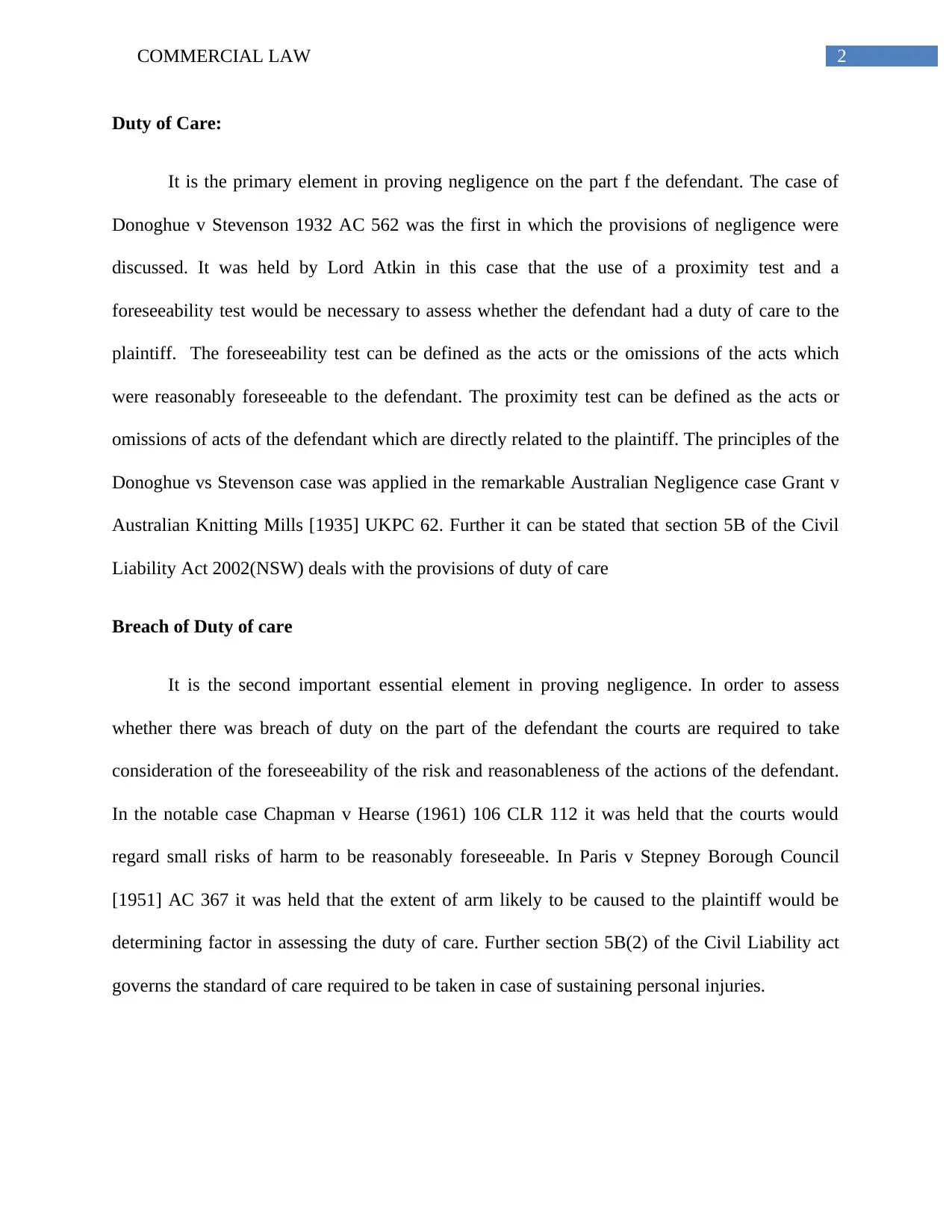
2COMMERCIAL LAW
Duty of Care:
It is the primary element in proving negligence on the part f the defendant. The case of
Donoghue v Stevenson 1932 AC 562 was the first in which the provisions of negligence were
discussed. It was held by Lord Atkin in this case that the use of a proximity test and a
foreseeability test would be necessary to assess whether the defendant had a duty of care to the
plaintiff. The foreseeability test can be defined as the acts or the omissions of the acts which
were reasonably foreseeable to the defendant. The proximity test can be defined as the acts or
omissions of acts of the defendant which are directly related to the plaintiff. The principles of the
Donoghue vs Stevenson case was applied in the remarkable Australian Negligence case Grant v
Australian Knitting Mills [1935] UKPC 62. Further it can be stated that section 5B of the Civil
Liability Act 2002(NSW) deals with the provisions of duty of care
Breach of Duty of care
It is the second important essential element in proving negligence. In order to assess
whether there was breach of duty on the part of the defendant the courts are required to take
consideration of the foreseeability of the risk and reasonableness of the actions of the defendant.
In the notable case Chapman v Hearse (1961) 106 CLR 112 it was held that the courts would
regard small risks of harm to be reasonably foreseeable. In Paris v Stepney Borough Council
[1951] AC 367 it was held that the extent of arm likely to be caused to the plaintiff would be
determining factor in assessing the duty of care. Further section 5B(2) of the Civil Liability act
governs the standard of care required to be taken in case of sustaining personal injuries.
Duty of Care:
It is the primary element in proving negligence on the part f the defendant. The case of
Donoghue v Stevenson 1932 AC 562 was the first in which the provisions of negligence were
discussed. It was held by Lord Atkin in this case that the use of a proximity test and a
foreseeability test would be necessary to assess whether the defendant had a duty of care to the
plaintiff. The foreseeability test can be defined as the acts or the omissions of the acts which
were reasonably foreseeable to the defendant. The proximity test can be defined as the acts or
omissions of acts of the defendant which are directly related to the plaintiff. The principles of the
Donoghue vs Stevenson case was applied in the remarkable Australian Negligence case Grant v
Australian Knitting Mills [1935] UKPC 62. Further it can be stated that section 5B of the Civil
Liability Act 2002(NSW) deals with the provisions of duty of care
Breach of Duty of care
It is the second important essential element in proving negligence. In order to assess
whether there was breach of duty on the part of the defendant the courts are required to take
consideration of the foreseeability of the risk and reasonableness of the actions of the defendant.
In the notable case Chapman v Hearse (1961) 106 CLR 112 it was held that the courts would
regard small risks of harm to be reasonably foreseeable. In Paris v Stepney Borough Council
[1951] AC 367 it was held that the extent of arm likely to be caused to the plaintiff would be
determining factor in assessing the duty of care. Further section 5B(2) of the Civil Liability act
governs the standard of care required to be taken in case of sustaining personal injuries.
⊘ This is a preview!⊘
Do you want full access?
Subscribe today to unlock all pages.

Trusted by 1+ million students worldwide
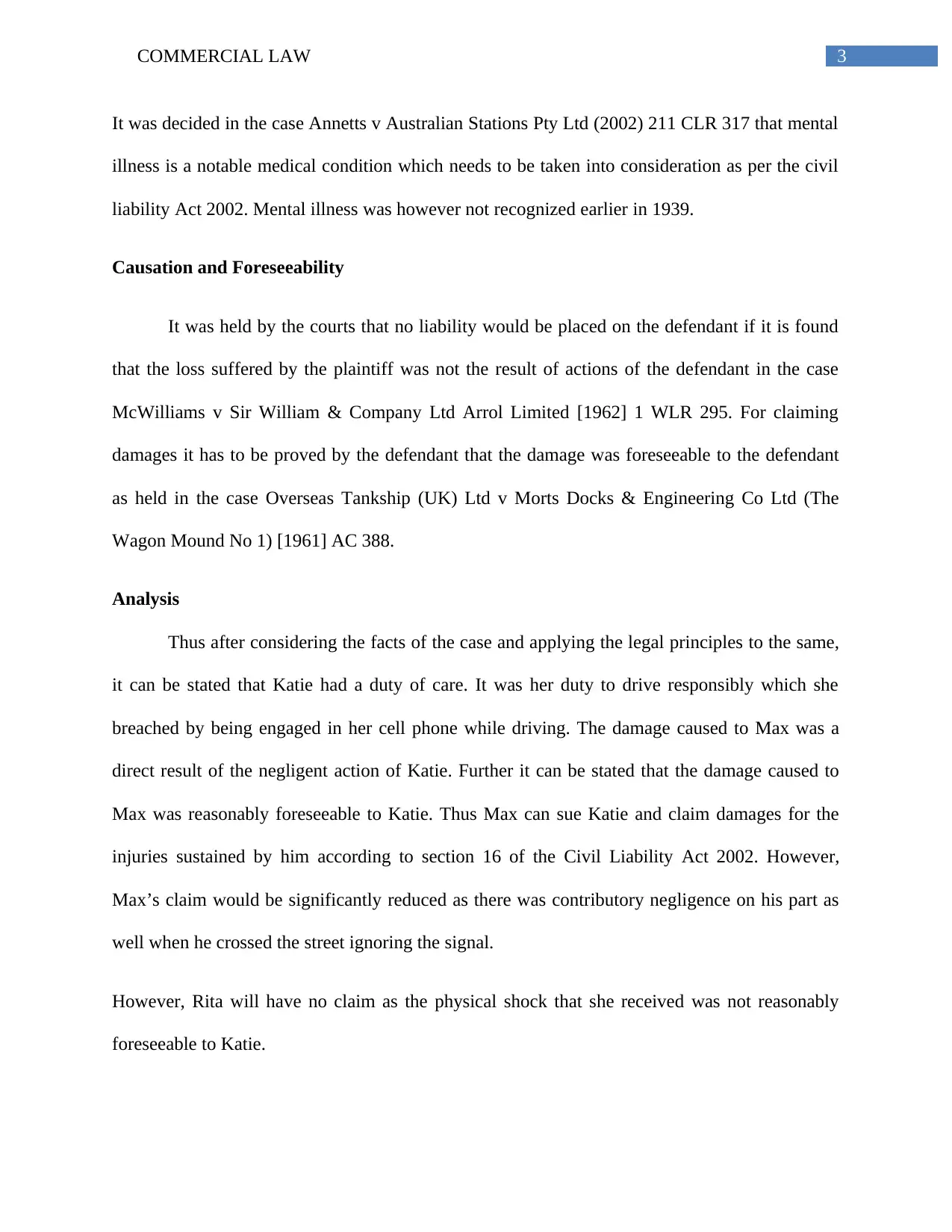
3COMMERCIAL LAW
It was decided in the case Annetts v Australian Stations Pty Ltd (2002) 211 CLR 317 that mental
illness is a notable medical condition which needs to be taken into consideration as per the civil
liability Act 2002. Mental illness was however not recognized earlier in 1939.
Causation and Foreseeability
It was held by the courts that no liability would be placed on the defendant if it is found
that the loss suffered by the plaintiff was not the result of actions of the defendant in the case
McWilliams v Sir William & Company Ltd Arrol Limited [1962] 1 WLR 295. For claiming
damages it has to be proved by the defendant that the damage was foreseeable to the defendant
as held in the case Overseas Tankship (UK) Ltd v Morts Docks & Engineering Co Ltd (The
Wagon Mound No 1) [1961] AC 388.
Analysis
Thus after considering the facts of the case and applying the legal principles to the same,
it can be stated that Katie had a duty of care. It was her duty to drive responsibly which she
breached by being engaged in her cell phone while driving. The damage caused to Max was a
direct result of the negligent action of Katie. Further it can be stated that the damage caused to
Max was reasonably foreseeable to Katie. Thus Max can sue Katie and claim damages for the
injuries sustained by him according to section 16 of the Civil Liability Act 2002. However,
Max’s claim would be significantly reduced as there was contributory negligence on his part as
well when he crossed the street ignoring the signal.
However, Rita will have no claim as the physical shock that she received was not reasonably
foreseeable to Katie.
It was decided in the case Annetts v Australian Stations Pty Ltd (2002) 211 CLR 317 that mental
illness is a notable medical condition which needs to be taken into consideration as per the civil
liability Act 2002. Mental illness was however not recognized earlier in 1939.
Causation and Foreseeability
It was held by the courts that no liability would be placed on the defendant if it is found
that the loss suffered by the plaintiff was not the result of actions of the defendant in the case
McWilliams v Sir William & Company Ltd Arrol Limited [1962] 1 WLR 295. For claiming
damages it has to be proved by the defendant that the damage was foreseeable to the defendant
as held in the case Overseas Tankship (UK) Ltd v Morts Docks & Engineering Co Ltd (The
Wagon Mound No 1) [1961] AC 388.
Analysis
Thus after considering the facts of the case and applying the legal principles to the same,
it can be stated that Katie had a duty of care. It was her duty to drive responsibly which she
breached by being engaged in her cell phone while driving. The damage caused to Max was a
direct result of the negligent action of Katie. Further it can be stated that the damage caused to
Max was reasonably foreseeable to Katie. Thus Max can sue Katie and claim damages for the
injuries sustained by him according to section 16 of the Civil Liability Act 2002. However,
Max’s claim would be significantly reduced as there was contributory negligence on his part as
well when he crossed the street ignoring the signal.
However, Rita will have no claim as the physical shock that she received was not reasonably
foreseeable to Katie.
Paraphrase This Document
Need a fresh take? Get an instant paraphrase of this document with our AI Paraphraser
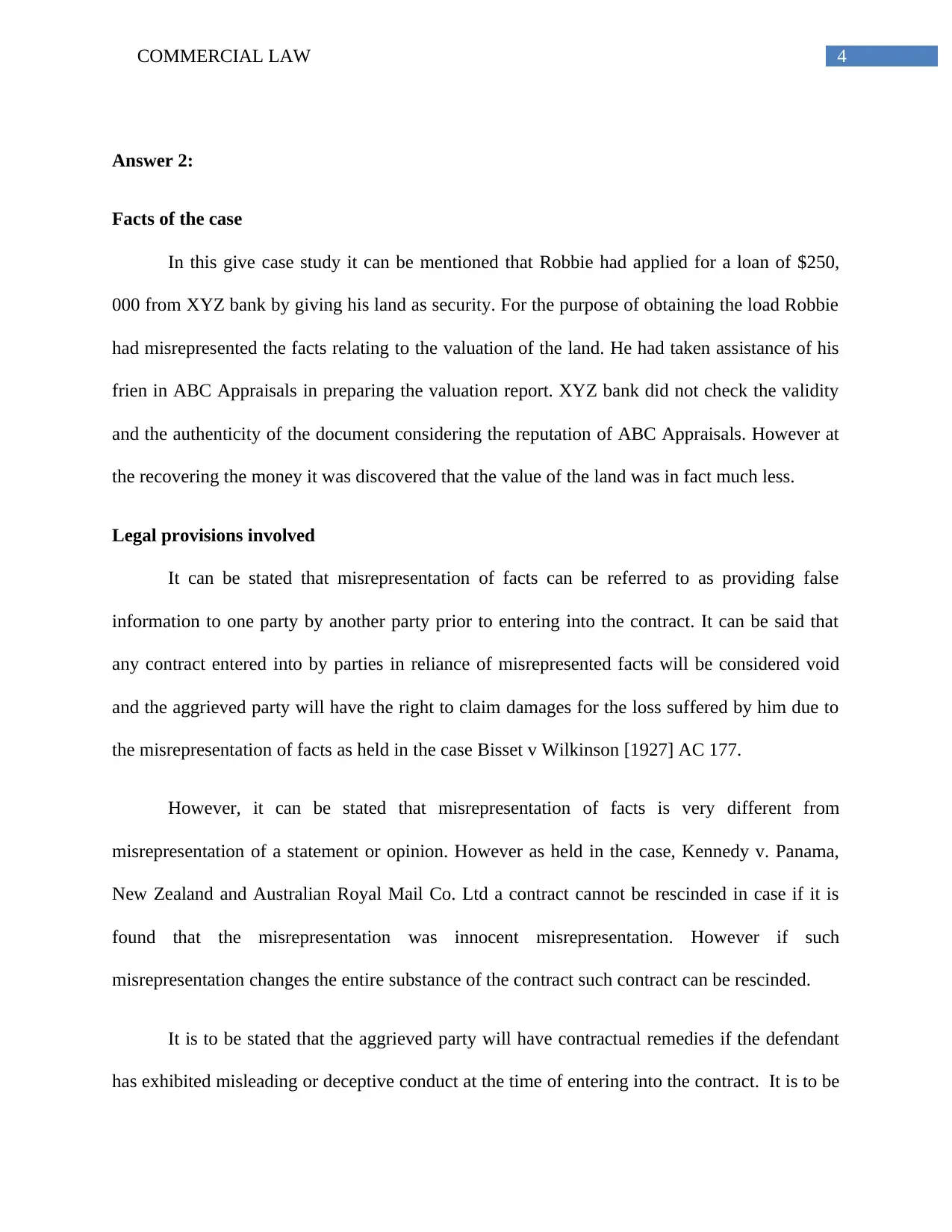
4COMMERCIAL LAW
Answer 2:
Facts of the case
In this give case study it can be mentioned that Robbie had applied for a loan of $250,
000 from XYZ bank by giving his land as security. For the purpose of obtaining the load Robbie
had misrepresented the facts relating to the valuation of the land. He had taken assistance of his
frien in ABC Appraisals in preparing the valuation report. XYZ bank did not check the validity
and the authenticity of the document considering the reputation of ABC Appraisals. However at
the recovering the money it was discovered that the value of the land was in fact much less.
Legal provisions involved
It can be stated that misrepresentation of facts can be referred to as providing false
information to one party by another party prior to entering into the contract. It can be said that
any contract entered into by parties in reliance of misrepresented facts will be considered void
and the aggrieved party will have the right to claim damages for the loss suffered by him due to
the misrepresentation of facts as held in the case Bisset v Wilkinson [1927] AC 177.
However, it can be stated that misrepresentation of facts is very different from
misrepresentation of a statement or opinion. However as held in the case, Kennedy v. Panama,
New Zealand and Australian Royal Mail Co. Ltd a contract cannot be rescinded in case if it is
found that the misrepresentation was innocent misrepresentation. However if such
misrepresentation changes the entire substance of the contract such contract can be rescinded.
It is to be stated that the aggrieved party will have contractual remedies if the defendant
has exhibited misleading or deceptive conduct at the time of entering into the contract. It is to be
Answer 2:
Facts of the case
In this give case study it can be mentioned that Robbie had applied for a loan of $250,
000 from XYZ bank by giving his land as security. For the purpose of obtaining the load Robbie
had misrepresented the facts relating to the valuation of the land. He had taken assistance of his
frien in ABC Appraisals in preparing the valuation report. XYZ bank did not check the validity
and the authenticity of the document considering the reputation of ABC Appraisals. However at
the recovering the money it was discovered that the value of the land was in fact much less.
Legal provisions involved
It can be stated that misrepresentation of facts can be referred to as providing false
information to one party by another party prior to entering into the contract. It can be said that
any contract entered into by parties in reliance of misrepresented facts will be considered void
and the aggrieved party will have the right to claim damages for the loss suffered by him due to
the misrepresentation of facts as held in the case Bisset v Wilkinson [1927] AC 177.
However, it can be stated that misrepresentation of facts is very different from
misrepresentation of a statement or opinion. However as held in the case, Kennedy v. Panama,
New Zealand and Australian Royal Mail Co. Ltd a contract cannot be rescinded in case if it is
found that the misrepresentation was innocent misrepresentation. However if such
misrepresentation changes the entire substance of the contract such contract can be rescinded.
It is to be stated that the aggrieved party will have contractual remedies if the defendant
has exhibited misleading or deceptive conduct at the time of entering into the contract. It is to be
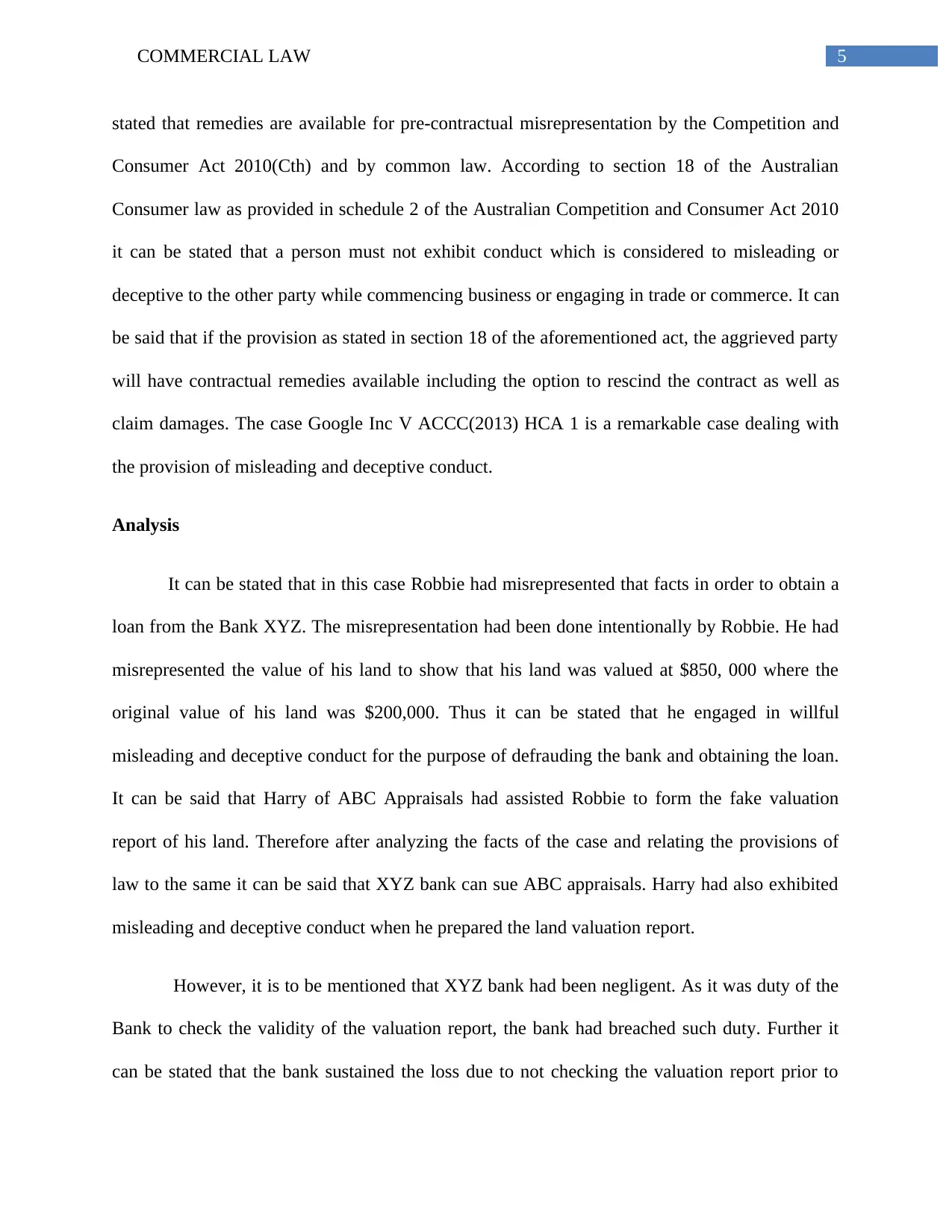
5COMMERCIAL LAW
stated that remedies are available for pre-contractual misrepresentation by the Competition and
Consumer Act 2010(Cth) and by common law. According to section 18 of the Australian
Consumer law as provided in schedule 2 of the Australian Competition and Consumer Act 2010
it can be stated that a person must not exhibit conduct which is considered to misleading or
deceptive to the other party while commencing business or engaging in trade or commerce. It can
be said that if the provision as stated in section 18 of the aforementioned act, the aggrieved party
will have contractual remedies available including the option to rescind the contract as well as
claim damages. The case Google Inc V ACCC(2013) HCA 1 is a remarkable case dealing with
the provision of misleading and deceptive conduct.
Analysis
It can be stated that in this case Robbie had misrepresented that facts in order to obtain a
loan from the Bank XYZ. The misrepresentation had been done intentionally by Robbie. He had
misrepresented the value of his land to show that his land was valued at $850, 000 where the
original value of his land was $200,000. Thus it can be stated that he engaged in willful
misleading and deceptive conduct for the purpose of defrauding the bank and obtaining the loan.
It can be said that Harry of ABC Appraisals had assisted Robbie to form the fake valuation
report of his land. Therefore after analyzing the facts of the case and relating the provisions of
law to the same it can be said that XYZ bank can sue ABC appraisals. Harry had also exhibited
misleading and deceptive conduct when he prepared the land valuation report.
However, it is to be mentioned that XYZ bank had been negligent. As it was duty of the
Bank to check the validity of the valuation report, the bank had breached such duty. Further it
can be stated that the bank sustained the loss due to not checking the valuation report prior to
stated that remedies are available for pre-contractual misrepresentation by the Competition and
Consumer Act 2010(Cth) and by common law. According to section 18 of the Australian
Consumer law as provided in schedule 2 of the Australian Competition and Consumer Act 2010
it can be stated that a person must not exhibit conduct which is considered to misleading or
deceptive to the other party while commencing business or engaging in trade or commerce. It can
be said that if the provision as stated in section 18 of the aforementioned act, the aggrieved party
will have contractual remedies available including the option to rescind the contract as well as
claim damages. The case Google Inc V ACCC(2013) HCA 1 is a remarkable case dealing with
the provision of misleading and deceptive conduct.
Analysis
It can be stated that in this case Robbie had misrepresented that facts in order to obtain a
loan from the Bank XYZ. The misrepresentation had been done intentionally by Robbie. He had
misrepresented the value of his land to show that his land was valued at $850, 000 where the
original value of his land was $200,000. Thus it can be stated that he engaged in willful
misleading and deceptive conduct for the purpose of defrauding the bank and obtaining the loan.
It can be said that Harry of ABC Appraisals had assisted Robbie to form the fake valuation
report of his land. Therefore after analyzing the facts of the case and relating the provisions of
law to the same it can be said that XYZ bank can sue ABC appraisals. Harry had also exhibited
misleading and deceptive conduct when he prepared the land valuation report.
However, it is to be mentioned that XYZ bank had been negligent. As it was duty of the
Bank to check the validity of the valuation report, the bank had breached such duty. Further it
can be stated that the bank sustained the loss due to not checking the valuation report prior to
⊘ This is a preview!⊘
Do you want full access?
Subscribe today to unlock all pages.

Trusted by 1+ million students worldwide
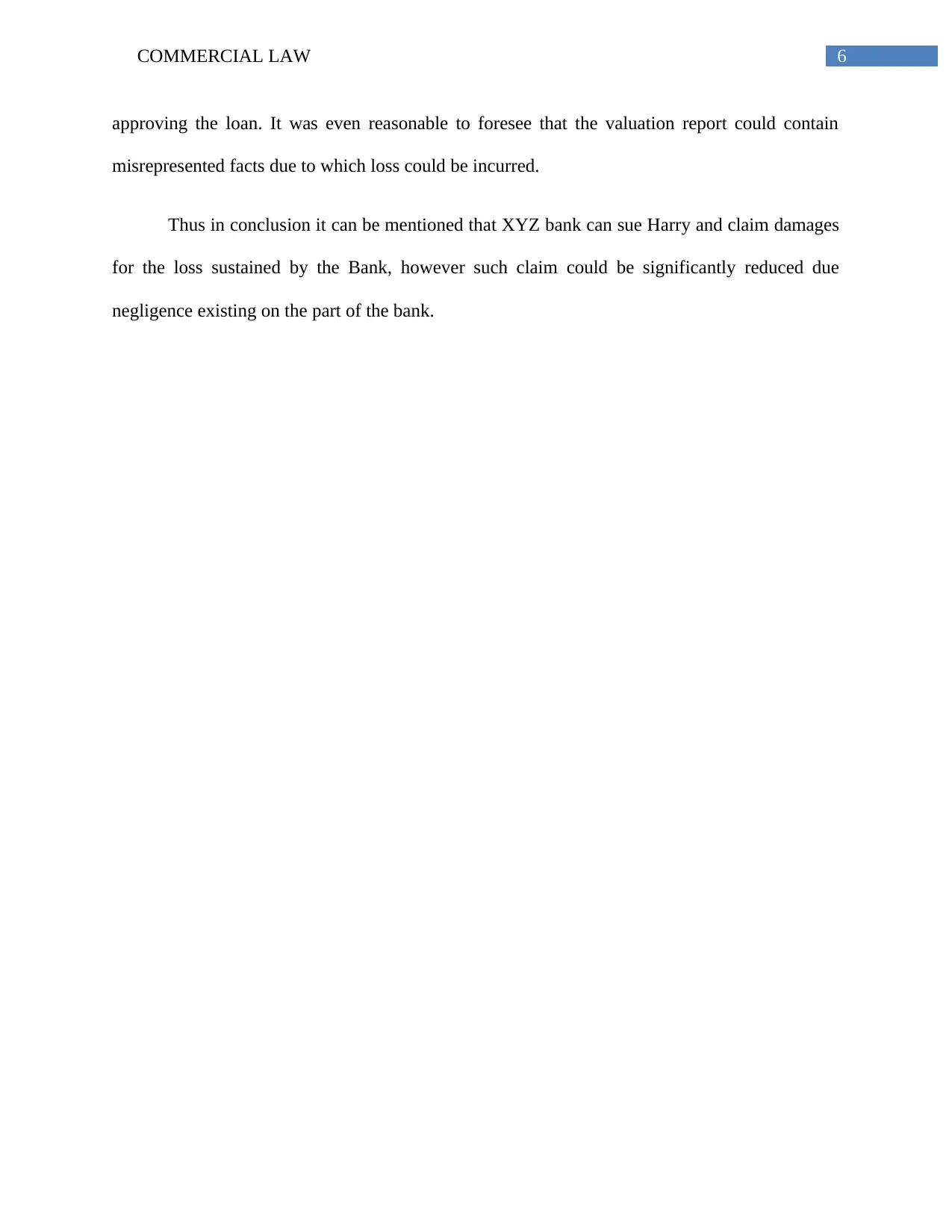
6COMMERCIAL LAW
approving the loan. It was even reasonable to foresee that the valuation report could contain
misrepresented facts due to which loss could be incurred.
Thus in conclusion it can be mentioned that XYZ bank can sue Harry and claim damages
for the loss sustained by the Bank, however such claim could be significantly reduced due
negligence existing on the part of the bank.
approving the loan. It was even reasonable to foresee that the valuation report could contain
misrepresented facts due to which loss could be incurred.
Thus in conclusion it can be mentioned that XYZ bank can sue Harry and claim damages
for the loss sustained by the Bank, however such claim could be significantly reduced due
negligence existing on the part of the bank.
Paraphrase This Document
Need a fresh take? Get an instant paraphrase of this document with our AI Paraphraser
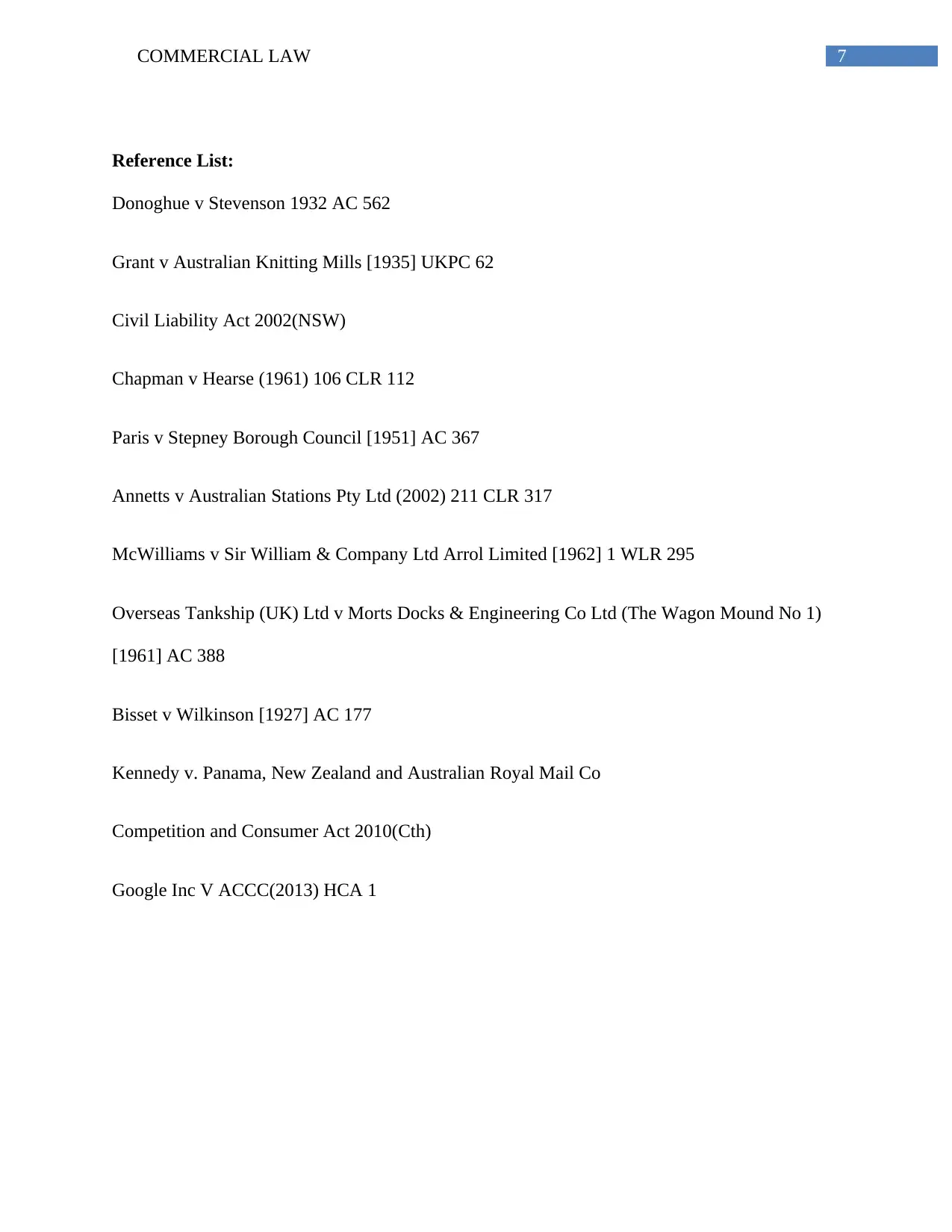
7COMMERCIAL LAW
Reference List:
Donoghue v Stevenson 1932 AC 562
Grant v Australian Knitting Mills [1935] UKPC 62
Civil Liability Act 2002(NSW)
Chapman v Hearse (1961) 106 CLR 112
Paris v Stepney Borough Council [1951] AC 367
Annetts v Australian Stations Pty Ltd (2002) 211 CLR 317
McWilliams v Sir William & Company Ltd Arrol Limited [1962] 1 WLR 295
Overseas Tankship (UK) Ltd v Morts Docks & Engineering Co Ltd (The Wagon Mound No 1)
[1961] AC 388
Bisset v Wilkinson [1927] AC 177
Kennedy v. Panama, New Zealand and Australian Royal Mail Co
Competition and Consumer Act 2010(Cth)
Google Inc V ACCC(2013) HCA 1
Reference List:
Donoghue v Stevenson 1932 AC 562
Grant v Australian Knitting Mills [1935] UKPC 62
Civil Liability Act 2002(NSW)
Chapman v Hearse (1961) 106 CLR 112
Paris v Stepney Borough Council [1951] AC 367
Annetts v Australian Stations Pty Ltd (2002) 211 CLR 317
McWilliams v Sir William & Company Ltd Arrol Limited [1962] 1 WLR 295
Overseas Tankship (UK) Ltd v Morts Docks & Engineering Co Ltd (The Wagon Mound No 1)
[1961] AC 388
Bisset v Wilkinson [1927] AC 177
Kennedy v. Panama, New Zealand and Australian Royal Mail Co
Competition and Consumer Act 2010(Cth)
Google Inc V ACCC(2013) HCA 1
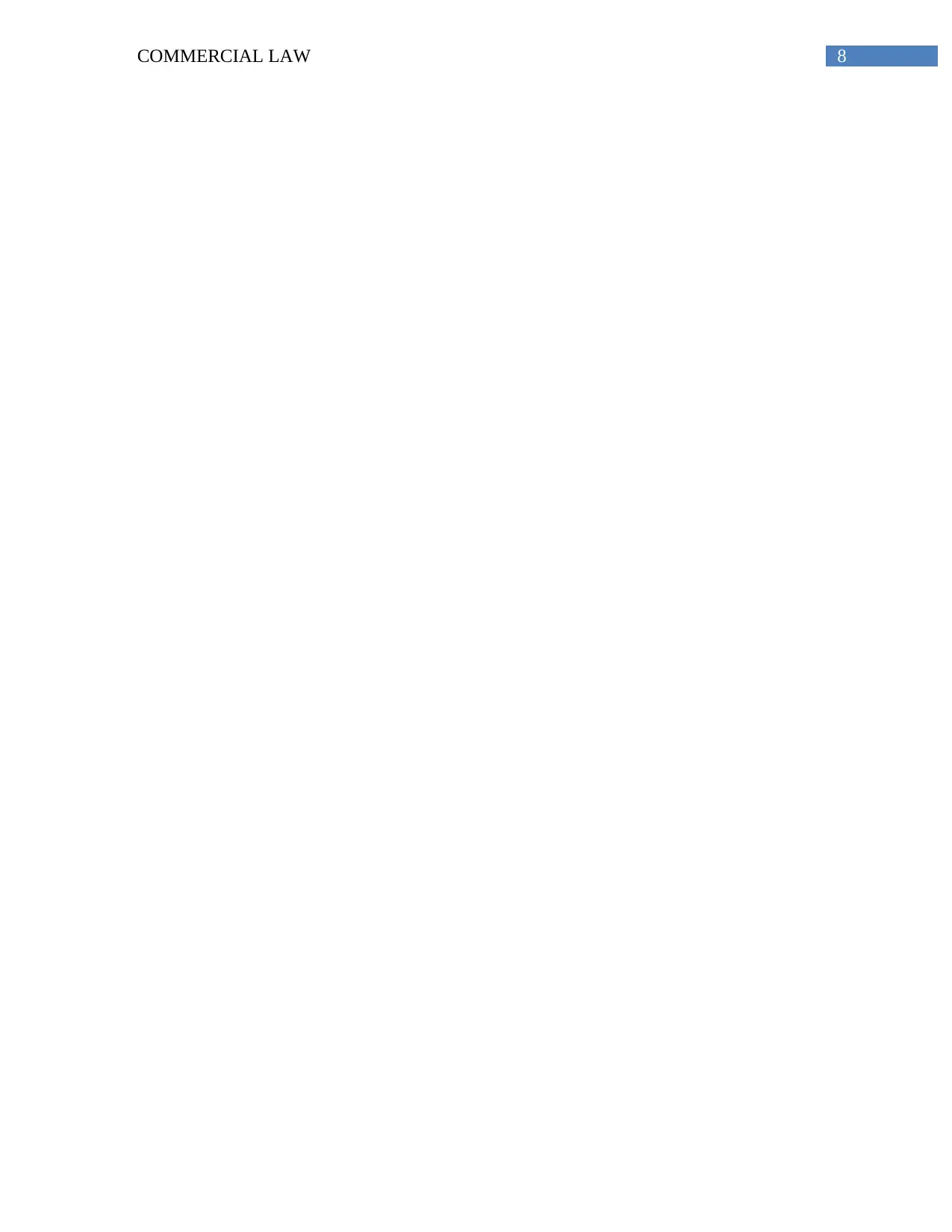
8COMMERCIAL LAW
⊘ This is a preview!⊘
Do you want full access?
Subscribe today to unlock all pages.

Trusted by 1+ million students worldwide
1 out of 9
Related Documents
Your All-in-One AI-Powered Toolkit for Academic Success.
+13062052269
info@desklib.com
Available 24*7 on WhatsApp / Email
![[object Object]](/_next/static/media/star-bottom.7253800d.svg)
Unlock your academic potential
Copyright © 2020–2025 A2Z Services. All Rights Reserved. Developed and managed by ZUCOL.





